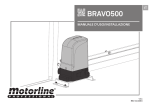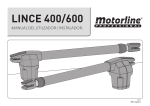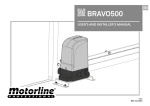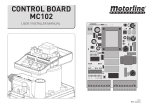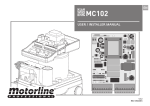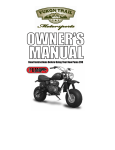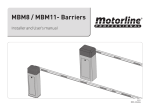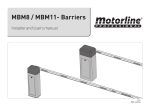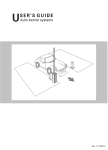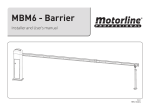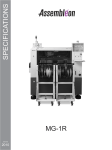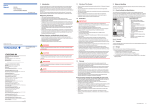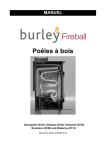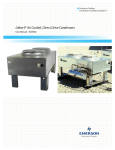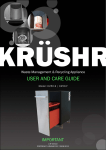Download USER`S AND INSTALLER`S MANUAL
Transcript
EN LINCE USER’S AND INSTALLER’S MANUAL v2.2 REV. 07/2015 00. CONTENT 01. SAFETY INSTRUCTIONS INDEX STANDARDS TO FOLLOW 01. SAFETY INSTRUCTIONS ATTENTION: STANDARDS TO FOLLOW 01B 02.PACKAGE INSIDE PACKAGE 02A 03. OPERATOR CHANGE MOTOR DIRECTION 02B MANUAL RELEASE 03B TECHNICAL SPECIFICATIONS 04A 04. INSTALLATION INSTALLATION DIMENSIONS 04B INSTALLATION STEPS 06A INSTALLATION MAP 07 05. TROUBLESHOOTING FINAL CONSUMERS INSTRUCTIONS 08 INSTRUCTIONS FOR SPECIALIZED INSTALLERS 08 06. COMPONENTS TEST CAPACITORS CONNECTION SCHEME 09A 07. MAINTENANCE MAINTENANCE • To ensure the safety of people, it is important that you read all the following instructions.Incorrect installation or incorrect use of the product can cause physical injury and material damage. • Keep these instructions in a safe place for future reference. • This product was designed and produced strictly for the use indicated in this manual. Any other use, not expressly indicated here, could compromise the good condition/ operation of the product and/or be a source of danger. • ELECTROCELOS S.A. is not responsible for the improper use of the product, or other use than that for which it was designed. • ELECTROCELOS S.A. is not responsible if safety standards were not taken into account when installing the equipment, or for any deformation that may occur to it. • ELECTROCELOS S.A. is not responsible for the safety and proper operation when using components not sold by them. • Do not make any modifications to the operator components and / or their accessories. • Beffore installation unplug the automatism from the source of power. • The installer must inform the client how to handle the product in case of emergency and provide this manual to user. • Keep remote controls away from children, to prevent the automated system from being activated involuntarily. • The customer shall not, under any circumstances, attempt to repair or tune the operator .Must call qualified technician only. • Connect the automatism to a 230V plug with ground wire. • Operator for outdoor and indoor use. 09B 08. CONTROL BOARD MC2 CONNECTIONS SCHEME 10 2A EN 2B EN 02. PACKAGE 03. OPERATOR INSIDE PACKAGE CHANGE MOTOR DIRECTION In the package you will find the following components: The operator LINCE, is a product developed exclusively for the automatic opening of swing gates. 01• 02 Swing operators LINCE 02• 01 Control Board 03• 02 transmitters 04• 02 Front supports 05• 02 Rear supports 06• 02 Capacitors 8μF 07• 01 Photocells 08• 01 User’s manual 09• 02 Release keys Besides being pratical, safe and powerful, this product has a new function incorporated so that you can transform a motor to apply on right leaves to left leaves. This allows greater flexibility in the use of each operator. 09• 04• 05• Middle part Upper part 08• Lower part 01• 06• 04 01 Motor disassembly and assembly process, in order to transform motor, must be done as follows: Electronic components the kit: 07• 03• 02• 02 210mm 280mm 05 810mm 03 3A EN 01 • Loosen the screws that secure the Lower Part to Middle Part 3B EN 06 02 • Remove Lower Part 03. OPERATOR 03. OPERATOR CHANGE MOTOR DIRECTION UNLOCK OPERATOR 07 03 • Loosen the screws of the Middle Part 09 05 • Rotate Upper Part 180° 08 04 • Remove Middle Part 01 • Remove the plastic cap from the rear end Information engraved on the unlock shaft D=Unlock || B=Lock 14 10 06 • Assemble operator by tightening all components with the screws 13 12 15 02 • Insert Release key on the unlock shaft. 03 • Rotate key 180 ° in the direction indicated in the figure to unlock 04 • Operator unlocked. 16 11 07 • Full transformed operator 4A EN 4B EN Note • To lock operator so it can work automatically, must do it by turning the key anticlockwise. 03. OPERATOR 04. INSTALLATION TECHNICAL SPECIFICATIONS VERTICAL INSTALLATION DIMENSIONS LINCE specifications are as follow: The operator LINCE must be installed with a small inclination , to prevent water infiltration through the extension arm. For this, the front support must be fixed to the gate with a height lower than the height of the rear support. See example below: LINCE300 LINCE400 LINCE600 AC 230V 50/60Hz AC 230V 50/60Hz AC 230V 50/60Hz • Power 180W 180W 180W • Current 1,3A 1,3A 1,3A 1400 RPM 1400 RPM 1400 RPM • Noise level <50dB <50dB <50dB • Force 2300N 2300N 2300N -25°C to 75°C -25°C to 75°C -25°C to 75°C 120°C 120°C 120°C • Protection class IP54 IP54 IP54 • Working frequence 25% 25% 25% • Course 300mm 400mm 600mm • Max leaf lenght 2500mm 3000mm 4000mm 8µF 8µF 8µF • Power Supply • RPM • Operating temperatures • Thermal protection • Capacitor A B A B 18 LINCE 300 || 400 || 600 dimensions are the following: Dimension A • Vertical distance from the floor to the top of the rear support . Dimension B • Vertical distance from the floor to the top of the front support. 962mm || 1162mm || 1562mm 175mm A ? mm B A-10mm • Set dimension A (this can be any size of your choice). • After you set dimension A, subtract 10mm to find dimensionB. Example: • If the height of the rear bracket (dimension A)is set at 600 mm, then the height of the front bracket (dimension B) will be 590 mm (600mm-10mm). 159mm 647mm || 747mm || 947mm 104mm It is very important that these dimensions are respected! Only this way can be assured the correct functioning and durability of the operators! It is also very important to have a levelled ground/terrain! 17 5A EN 5B EN 04. INSTALLATION 04. INSTALLATION VERTICAL INSTALLATION DIMENSIONS HORIZONTAL INSTALLATION DIMENSIONS On the Illustrated diagrams below and on the next page, are the horizontal dimensions for the installation of the automated system. INTERIOR OPENING EXTERIOR OPENING Axis of rotation of the motor, on the front bracket (EXTERIOR) Opening mechanical stopper Opening direction Closing mechanical stopper Axis of rotation of the gate (center of the door hinge) (EXTERIOR) Y W Distance between the centers of the holes on the supports from operator X Axis of rotation of the motor, on the rear support Axis of rotation of the gate (center of the door hinge) Y Opening direction (INTERIOR) Opening mechanical stopper • LINCE300 • LINCE400 • LINCE600 Axis of rotation of the motor, on the rear support 19 X Y W 95º 120 a 180 120 a 180 895 a 900 • LINCE300 95º 120 a 180 120 a 180 1095 a 1100 120º 160 a 180 120 a 140 1095 a 1100 95º 120 a 350 120 a 200 1495 a 1500 120º 200 a 280 120 a 200 1495 a 1500 Opening angle It is very important that these dimensions are respected! Only this way can be assured the correct functioning and durability of the operators! 6A EN Axis of rotation of the motor, on the front support X (INTERIOR) Opening angle Closing mechanical stopper W Distance between the centers of the holes on the supports from operator X Y W 95º 120 a 180 120 a 180 595 a 600 • LINCE400 95º 160 a 200 120 a 180 695 a 700 • LINCE600 95º 160 a 300 120 a 280 900 a 905 Legend: Dimension X - Horizontal distance between hinge axis of the door and the rear axle of the motor. Dimension Y - Vertical distance between hinge axis of the door and the rear axle of the motor. Dimension W - Distance between axis of the motor brackets. 6B EN 20 04. INSTALLATION 04. INSTALLATION INSTALLATION STEPS INSTALLATION STEPS 04 • Install operator on the supports Pay attention to installation dimensions mentioned on pages 04B, 05A and 05B! 01 • Fixing rear support • The Rear support must be fixed to the pillar or wall using dimensions provided in the preceding pages. It can be fixed using screws with mechanical bushing or chemical welding process, or one of your choice since it provides an appropriate support. 24 • The operator must be placed on both supports the same time to avoid leaving the operator suspended by only one of the supports. To make the task easier, you should unlock the operator in order to be able to stretch / retract arm easily (see page 03B),to get the correct position for supports. 05 • Test movement 21 02 • Fixing front support • The Front support should be fixed to the gate, respecting height dimensions and distance to the rear support. This may be fixed by using screws, welding process, or to choose another long as it provides a secure proper support. 25 • Install the pins removed earlier on each place with a small amount of lubricant for less friction. • Move the door manually to see if the door opens and closes uniformly and correctly, without any irregular friction during its entire travel; This will ensure that operator is not subjected to problems during operation. 06 • Connecting operator to control board and configuring control devices. 22 03 • Remove caps and pins from motor • Before installing motor, remove caps and pins from motor. 26 • At the end of the installation, put back plastic covers for a better visual finish of the operator. • With the operator installed, connect it to control board for system configuration (see control board user manual). Must also configure the desired control devices (transmitters, wall switch, etc.) and other additional components such as antenna, warning light, key selector, among others. It is important to respect this installation order! Otherwise, it is not possible to ensure correct installation and operators may not work properly! 23 7A EN 7B EN 04. INSTALLATION INSTALLATION MAP • INTERIOR PHOTOCELLS • EXTERIOR PHOTOCELLS • MOTOR LINCE • EXTERIOR PHOTOCELLS • KEY SELECTOR • WARNING LAMP • ANTENNA • CONTROL BOARD • JUNCTION BOX LEGEND: • Connection cables 27 It is important to use mechanical stoppers in the opening and closing position of the gate.If not respected, components of the automation may suffer efforts for which they were not prepared, and as a result will be damaged. It is important to use junction boxes for connections between motors, components and control unit. All cables must enter and exit on the bottom of the junction and control board box. 8 EN 05. TROUBLESHOOTING INSTRUCTIONS FOR SPECIALIZED INSTALLERS FINAL CONSUMERS INSTRUCTIONS Anomaly Procedure Behavior • Still not working Procedure II • Motor doesn't work at all •Make sure you have 230V power supply connected to operator and if it is working properly. • Motor doesn’t move but makes noise • Unlock motor and • Encountered • Consult an experienced move gate by hand to problems? gate expert check for mechanical problems on the gate. •Gate moves easily? • Consult a qualified MOTORLINE technician. • Motor opens • Unlock motor and • Gate opened but but doesn’t move gate by hand to didn’t close again. close closed position. Lock motor(s) again and turn off power supply for 5 seconds. Reconnect it and send order to open gate using transmitter. • Motor doesn’t make complete route • Consult a qualified MOTORLINE technician. 1 • Check if there is any obstacle in front of the photocells; 2 • Check if any of the control devices (key selector, push button, video intercom, etc.) of the gate are jammed and sending permanent signal to control unit; 3 • Consult a qualified MOTORLINE technician. • Unlock motor and • Encountered • Consult an experienced move gate by hand to problems? gate expert check for mechanical problems on the gate. • Gate moves easily? • Consult a qualified MOTORLINE technician. Discovering the origin of the problem 1 • Open control box and check if it has 230V power supply; 2 • Check input fuses; 3 • Disconnect motors from control board and test them by connecting directly to power supply in order to find out if they have problems (see page 09A). 4 • If the motors work, the problem is on the control board. Pull it out and send it to our MOTORLINE technical services for diagnosis; 5 • If the motors doesn’t work, remove them from installation site and send to our MOTORLINE technical services for diagnosis. 1 • Check all motion axis and associated motion systems related with gate and operators (pins, hinges, etc.) to find out what is the problem. 1 • Check capacitors, testing operator with new capacitors; 2 • If capacitors are not the problem, disconnect motors from control board and test them by connecting directly to power supply in order to find out if they have problems (see page 09A). All MOTORLINE control boards have LEDs that easily allow to conclude which devices are with anomalies. All safety devices LEDs (DS) in normal situations remain On. All "START" circuits LEDs in normal situations remain Off. If LEDs devices are not all On, there is some security systems malfunction (photocells, safety edges), etc. If "START" circuits LEDs are turn On, there is a control device sending permanent signal. 3 • If the motors work, the problem is from control board. Pull it out and send it to our MOTORLINE technical services for diagnosis; 4 • If the motors doesn’t work, remove them from installation site and send to our MOTORLINE technical services for diagnosis. A) SECURITY SYSTEMS: B) START SYSTEMS: 1 • Close with a shunt all safety systems on the control board (check manual of the control board in question). If the automated system starts working normally check for the problematic device. 2 • Remove one shunt at a time until you find the malfunction device . 3 • Replace it for a functional device and check if the operator works correctly with all the other devices. If you find another one defective, follow the same steps until you find all the problems. 1 • Disconnect all wires from START terminal input. 2 • If the LED turned Off, try reconnecting one device at a time until you find the defective device. NOTE: n case procedures described in sections A) and B) don’t result, remove control board and send to our technical services for diagnosis. 1 • Check all motion axis and associated motion systems related with gate and operators (pins, hinges, etc.) to find out what is the problem. 1 • Check capacitors, testing with new capacitors; 2 • If capacitors are not the problem, disconnect motors from control board and test them by connecting directly to power supply in order to find out if they are faulty; 3 • If the motors doesn’t work, remove them from installation site and send to our MOTORLINE technical services for diagnosis. 4 • If motors work well and move gate at full force during the entire course, the problem is from controller. Set force using trimmer on the board. Make a new working time programming , giving suffient time for opening and closing with appropriate force (see manual of the controller in question). 5 • If this doesn’t work, remove control unit and send it to MOTORLINE technical services services. NOTE: Setting force of the controller should be sufficient to make the gate open and close without stopping, but should stop with a little effort from a person. In case of safety systems failure, the gate shall never cause physical damaged to obstacles (vehicles, people, etc.). 9 EN 06. COMPONENTS TEST 07. MAINTENANCE CAPACITORS CONNECTION SCHEME MAINTENANCE To detect which components have problems on an automated system, sometimes it is necessary to conduct tests using a direct connection to a 230V AC power supply. For this it is necessary to merge a 8μF capacitor to make the operator to work. In the diagram below is shown how this link should be made and how to merge the different wires of the components. • Clean stainless steel arm • With a cloth soaked in lubricant spray, wipe any residue that accumulates on the operator’s stainless steel arm. • Apply a small amount of spray lubricant on the arm and using a dry cloth remove the excess, leaving a homogeneous layer of lubricant over the arm. NOTES: • To perform these tests you don’t need to remove operator from where it is installed, because this way you can know if connected directly to power supply it will work correctly. • The order of wiring capacitor to motor wires is not important, as long you connect one wire to Brown wire of motor and the other one to Black wire of motor; • Common wire should always be connected to power supply. • To reverse motor direction, just replace Black wire with Brown wire of the operator on the power supply. Common (Blue) OPERATOR LINCE 29 • Lubricate pins • Remove front and rear caps • Place a small amount of lubricant on the holes that contains support pins. • Install caps on the respective holders. 230V POWER SUPPLY 30 • Check motor supports Black •Make sure that supports remain well fixed on the pillars and gate to ensure proper functioning of the equipment.vz Brown Earth wire CAPACITOR 8µF 31 28 All tests must be performed by qualified personnel due to serious danger associated with the misuse of electrical systems! These maintenance measures must be applied every year in order to insure proper functioning of the automated system. 10A 10B EN EN 2 N 110V Earth wire 8 µ 4 LAMP 3 Light Bulb L N L 110V 1 6 7 MOTORE 1 AP COM CH 5 9 10 MOTORE 2 AP COM CH 8 Black Motor 2 Black Blue Brown NOTE • If any one of the motors moves in the wrong way, just switch the brown and black cables of that motor to change the direction. - Motor 1 starts opening before Motor 2 - Motor 2 starts closing before Motor 1 - It must be applied an 8µ capacitor in each motor, on the opening and closing wires as explained above. PL 3 8 µ Brown Motor 1 2 Earth wire 1 V 1 2 4 PUL 5 6 8 DS2 - + ~ ~ 5 NC 3 4 5 K2 Close the circuit with bridge (shunt) when the photocells circuit is not being used! ~ ~ + - - + 0V 12/24V COM ~ ~ 4 COM NC NO 1 K1 10V 12/24V 2 2 NC 3 K2 COM NC NO Interior Photocells ~ ~ + - 2 0V 12/24V COM 1 10V 12/24V 2 K1 Antenna 9 10 11 12 Pedestrian Opening (1 leaf) PED DS1 7 Exterior Photocells Complete Opening (2 leaves) Lock SERR. 3 PUL PED DS1 DS2 - Force + T.RIT.ANT T. PAUSA T.MOT.PED T.MOTOR INB.CMD.AP CODE PED CODE AUT/P-P 08. CONTROL BOARD MC2 CONNECTIONS SCHEME Blue 32 11 EN














